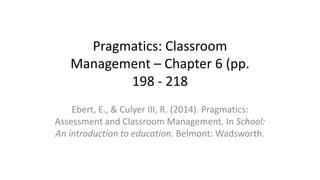
Chapter 6 pragmatics - classroom management
- 1. Pragmatics: Classroom Management – Chapter 6 (pp. 198 - 218 Ebert, E., & Culyer III, R. (2014). Pragmatics: Assessment and Classroom Management. In School: An introduction to education. Belmont: Wadsworth.
- 3. Where to Begin? • Is the curriculum “meaningful to the students”? • Is the teaching “engaging and motivating”? • What types of things derail these best of plans and intentions?
- 4. Some Theory • Read through the overview of Classroom Management Theories. • Are you more teacher-centered, student-centered, or somewhere in the middle? • Read the “Teacher Testimonial” on pp. 200 – 201. Which suggestions make you say “Aha!”?
- 5. Terminology • Classroom management – the things teachers do “to organize students, space, and time to prevent or minimize behavior problems that would interfere with instructional time.” • Discipline (according to the text) – “actions a teacher takes after misbehavior has occurred.” • Consequences – must be clear, fair and reasonable, and consistently enforced. Children will test limits, so be prepared. • Procedures – “manner in which particular activities are to be carried out” • Routines – “automatic” procedures
- 6. • Are students aware of the rules? • Are the rules fair and reasonable? • Is following the rules in the best interest of the students? • Is positive behavior encouraged? • What is the teacher doing to reduce the need for reinforcers?
- 7. Planning for Classroom Management • Curriculum is generally static • Student groups are dynamic • Organization is a must to keep all groups, no matter their makeup, maximizing instructional opportunities and minimizing behaviors that take away from that. • Much effective classroom management is inherent in what is not seen. (Note chart 6.4 on p. 205)
- 8. Practicing for Classroom Management • Practice following the rules, procedures, and routines • Allow the children to experience what it is that the teacher wants – What does it look like? – What does it sound like? – What does it feel like?
- 9. Implementing the Plan Teacher Thoughts Teacher Actions Student Thoughts Student Actions
- 10. Communicate Those Thoughts! • Communicate expectations • Involve the students • Make sure the expectations are positive, facilitate instruction, and support positive student development.
- 11. Why do students misbehave? • Need to belong • Need for power • Need for freedom • Need for fun • William Glasser (1997) suggested we lead students rather than “boss” them and help them make correct choices that help them fulfill those 4 needs.
- 12. Where to Draw the Line? • Students must understand there are limitations in a society and that is a part of their educational experience • If students feel they have a stake in the guidelines, they are more likely to feel they belong • Debate “If the rules are worth following, the following of them should be rewarding”
- 13. Which View? • “’buying’ rule conformity” • “my way or the highway” • teacher-centered • Principles of Effective Discipline • Emphasis on interpersonal relationships – Communicating expectations – Involving students in development of rules and procedures – View rules and procedures as positive boundaries
- 14. Principles for Effective Discipline • For the soft hearted (and anyone else) – Respond to the behavior – Provide appropriate consequences – Enforce – Always!!! – Consider extenuating circumstances, but still respond to the inappropriate behavior • Excuses • Power struggles • Volatile situations – Recognize situations that go beyond the classroom – Implement problem-solving conferences as needed (see steps on p. 210) Note: these are not alternatives to consequences, but are in addition to consequences
- 15. Implementation- What to Do? • Practice • Best Teacher Behaviors – “Withit ” – Handle multiple situations at once – Handle transitions smoothly
- 16. Implementation (cont.) • Room Arrangement – Efficient – Accessible • For “stuff” –pencil sharpeners, materials, etc. • For moving around and proximity to students – Visible • Teachers can see all the activity in the room • Students can participate and see everything they need to see.
- 17. What Else? • Committees • Parents • Planning for Substitutes • Other?